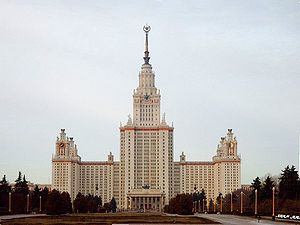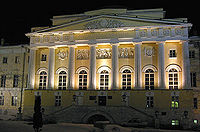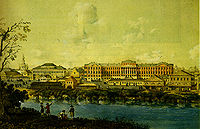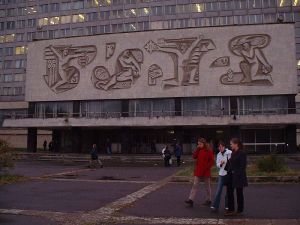Difference between revisions of "Moscow State University" - New World Encyclopedia
Nick Perez (talk | contribs) |
|||
| Line 23: | Line 23: | ||
'''M.V. Lomonosov Moscow State University''' ({{lang-ru|Московский государственный университет имени М.В.Ломоносова}}, often abbreviated '''МГУ''', '''MSU''', '''MGU''') is the largest [[university]] in [[Russia]]. Founded in 1755, [[List of oldest universities in continuous operation|it is also the oldest]]. As of 2004, the university has some 4,000 staff teaching 31,000 students and 7,000 postgraduates. Its current [[rector]] is [[Viktor Sadovnichiy]]. | '''M.V. Lomonosov Moscow State University''' ({{lang-ru|Московский государственный университет имени М.В.Ломоносова}}, often abbreviated '''МГУ''', '''MSU''', '''MGU''') is the largest [[university]] in [[Russia]]. Founded in 1755, [[List of oldest universities in continuous operation|it is also the oldest]]. As of 2004, the university has some 4,000 staff teaching 31,000 students and 7,000 postgraduates. Its current [[rector]] is [[Viktor Sadovnichiy]]. | ||
| + | |||
| + | ==Mission and Reputation== | ||
==History== | ==History== | ||
| − | + | ||
The university was established on the instigation of [[Ivan Shuvalov]] and [[Mikhail Lomonosov]] by a decree of [[Elizabeth of Russia|Russian Empress Elizabeth]] dated January 25 (January 12 old style), 1755. First lessons were held on April 26. January 25 is still celebrated as [[Tatiana Day|Students' Day in Russia]]. | The university was established on the instigation of [[Ivan Shuvalov]] and [[Mikhail Lomonosov]] by a decree of [[Elizabeth of Russia|Russian Empress Elizabeth]] dated January 25 (January 12 old style), 1755. First lessons were held on April 26. January 25 is still celebrated as [[Tatiana Day|Students' Day in Russia]]. | ||
| Line 31: | Line 33: | ||
In the 18th century, the university had three faculties: [[philosophy]], [[medicine]], and [[law]]. A college for future students was affiliated with the university before being abolished in 1812. In 1779, [[Mikhail Kheraskov]] founded a boarding school for noblemen (Благородный пансион), which was transformed into a gymnasium for the [[Russian nobility]] in 1830. The university press, run by [[Nikolay Novikov]] in the 1780s, published the most popular newspaper in Imperial Russia—''[[Moskovskie Vedomosti]]''. | In the 18th century, the university had three faculties: [[philosophy]], [[medicine]], and [[law]]. A college for future students was affiliated with the university before being abolished in 1812. In 1779, [[Mikhail Kheraskov]] founded a boarding school for noblemen (Благородный пансион), which was transformed into a gymnasium for the [[Russian nobility]] in 1830. The university press, run by [[Nikolay Novikov]] in the 1780s, published the most popular newspaper in Imperial Russia—''[[Moskovskie Vedomosti]]''. | ||
| − | |||
In 1804, medical education was split into Clinical ([[therapy]]), [[Surgery|Surgical]], and [[Obstetrics]] faculties. In 1884-1897, the Department of Medicine, supported by private donations, City Hall, and the national government, built an extensive, 1.6 [[kilometer]] long, state-of-the-art medical campus in [[Devichye Pole]], between the [[Garden Ring]] and [[Novodevichy Convent]]. It was designed by [[Konstantin Bykovsky]], with University doctors like [[Nikolay Sklifosovskiy]] and Fyodor Erismann acting as consultants. The campus, and medical education in general, were separated from the University in 1918. Devichye Pole is now operated by the independent [[Moscow Medical Academy]] and various other state and private institutions. | In 1804, medical education was split into Clinical ([[therapy]]), [[Surgery|Surgical]], and [[Obstetrics]] faculties. In 1884-1897, the Department of Medicine, supported by private donations, City Hall, and the national government, built an extensive, 1.6 [[kilometer]] long, state-of-the-art medical campus in [[Devichye Pole]], between the [[Garden Ring]] and [[Novodevichy Convent]]. It was designed by [[Konstantin Bykovsky]], with University doctors like [[Nikolay Sklifosovskiy]] and Fyodor Erismann acting as consultants. The campus, and medical education in general, were separated from the University in 1918. Devichye Pole is now operated by the independent [[Moscow Medical Academy]] and various other state and private institutions. | ||
| Line 49: | Line 50: | ||
After 1991, nine new faculties were established. In 1992, the university was granted a unique status: it is funded directly from the state budget (bypassing the ministry of education) which provides a significant level of independence. | After 1991, nine new faculties were established. In 1992, the university was granted a unique status: it is funded directly from the state budget (bypassing the ministry of education) which provides a significant level of independence. | ||
| − | == | + | ==Facilities== |
[[Image:Msu-main-seabhcan.JPG|thumb|left|MSU Main Tower]] | [[Image:Msu-main-seabhcan.JPG|thumb|left|MSU Main Tower]] | ||
| − | |||
Since 1953, most of the faculties have been situated on [[Sparrow Hills]], in the southwest of Moscow. The Main building was designed by [[architect]] [[Lev Vladimirovich Rudnev]]. In the post-war era, [[Stalin]] ordered [[Seven Sisters (Moscow)|seven huge tiered neoclassic towers]] built around the city. The MSU Main building is by far the largest of these. It was also the tallest building in the world outside of [[New York City]] at the time of its construction, and it remained the tallest building in Europe until 1988. The central tower is 240m tall, 36-stories high, and flanked by four huge wings of student and faculty accommodations. It is said to contain a total of 33 kilometers of corridors and 5,000 rooms. Facilities available inside the building include a concert hall, a theatre, a museum, various administration services, a library, a swimming pool, a police station, a post office, a laundry, a hairdresser's salon, a canteen, bank offices, shops, cafeterias, a bomb shelter, etc. Along with the university administration, four of the main faculties - [[MSU Faculty of Mechanics and Mathematics|Faculty of Mechanics and Mathematics]], the [[MSU Faculty of Geology|Faculty of Geology]], the [[MSU Faculty of Geography|Faculty of Geography]], and the [[MSU Faculty of Fine and Performing Arts|Faculty of Fine and Performing Arts]] - now remain in the Main buiding. The star on the top of the tower is large enough to include a small room and a viewing platform; it weighs 12 tons. The building's facades are ornamented with giant clocks, barometers, and thermometers, statues, carved wheat sheaves, and Soviet crests (recently renovated). It stands before a terrace featuring statues of male and female students gazing optimistically and confidently into the future. | Since 1953, most of the faculties have been situated on [[Sparrow Hills]], in the southwest of Moscow. The Main building was designed by [[architect]] [[Lev Vladimirovich Rudnev]]. In the post-war era, [[Stalin]] ordered [[Seven Sisters (Moscow)|seven huge tiered neoclassic towers]] built around the city. The MSU Main building is by far the largest of these. It was also the tallest building in the world outside of [[New York City]] at the time of its construction, and it remained the tallest building in Europe until 1988. The central tower is 240m tall, 36-stories high, and flanked by four huge wings of student and faculty accommodations. It is said to contain a total of 33 kilometers of corridors and 5,000 rooms. Facilities available inside the building include a concert hall, a theatre, a museum, various administration services, a library, a swimming pool, a police station, a post office, a laundry, a hairdresser's salon, a canteen, bank offices, shops, cafeterias, a bomb shelter, etc. Along with the university administration, four of the main faculties - [[MSU Faculty of Mechanics and Mathematics|Faculty of Mechanics and Mathematics]], the [[MSU Faculty of Geology|Faculty of Geology]], the [[MSU Faculty of Geography|Faculty of Geography]], and the [[MSU Faculty of Fine and Performing Arts|Faculty of Fine and Performing Arts]] - now remain in the Main buiding. The star on the top of the tower is large enough to include a small room and a viewing platform; it weighs 12 tons. The building's facades are ornamented with giant clocks, barometers, and thermometers, statues, carved wheat sheaves, and Soviet crests (recently renovated). It stands before a terrace featuring statues of male and female students gazing optimistically and confidently into the future. | ||
| − | + | [[Image:Staruniversity.jpg|thumb|left|200px|Today, the Old Building housed Departments of Psychology and Journalism.]] | |
While the [[Sparrow Hills]] were on the outskirts of the city at the time of the construction of the Main building, they are now about halfway from the [[Kremlin]] to the city limits. Several other buildings and sports facilities were later added to the city campus, including the only baseball stadium in Russia. Currently, a new building is under construction for the social sciences faculties, and a vast new facility has just been built for the library, which is the second largest in Russia by volume (number of books). The university also has several dormitory buildings in the southwest of Moscow outside the campus. | While the [[Sparrow Hills]] were on the outskirts of the city at the time of the construction of the Main building, they are now about halfway from the [[Kremlin]] to the city limits. Several other buildings and sports facilities were later added to the city campus, including the only baseball stadium in Russia. Currently, a new building is under construction for the social sciences faculties, and a vast new facility has just been built for the library, which is the second largest in Russia by volume (number of books). The university also has several dormitory buildings in the southwest of Moscow outside the campus. | ||
The historical buiding on Mokhovaya Street now houses mainly the [[MSU Faculty of Journalism|Faculty of Journalism]], the [[MSU Faculty of Psychology|Faculty of Psychology]], and the [[MSU The Institute of Asian and African Studies|The Institute of Asian and African Studies]]. | The historical buiding on Mokhovaya Street now houses mainly the [[MSU Faculty of Journalism|Faculty of Journalism]], the [[MSU Faculty of Psychology|Faculty of Psychology]], and the [[MSU The Institute of Asian and African Studies|The Institute of Asian and African Studies]]. | ||
| − | + | [[Image:mgu 1798.jpg|thumb|right|200px|Main buildings of the university in the Mokhovaya Street, 1798.]] | |
| + | |||
| + | ==Programs== | ||
| + | |||
| + | ==Colleges== | ||
| − | |||
[[Image:Msu-Languagebuilding-seabhcan.JPG|thumb|right|The Language Building]] | [[Image:Msu-Languagebuilding-seabhcan.JPG|thumb|right|The Language Building]] | ||
As of 2005, the university has 29 faculties and 15 research centers: | As of 2005, the university has 29 faculties and 15 research centers: | ||
| Line 94: | Line 97: | ||
*[[MSU Faculty of Military Training|Faculty of Military Training]] | *[[MSU Faculty of Military Training|Faculty of Military Training]] | ||
| − | |||
*[http://www.npi.msu.su/ Skobeltsyn Institute of Nuclear Physics] | *[http://www.npi.msu.su/ Skobeltsyn Institute of Nuclear Physics] | ||
*[http://www.imec.msu.ru/ Institute of Mechanics] | *[http://www.imec.msu.ru/ Institute of Mechanics] | ||
| Line 103: | Line 105: | ||
*[[White Sea Biological Station]] | *[[White Sea Biological Station]] | ||
*''and several others'' | *''and several others'' | ||
| + | |||
| + | ==Student Life== | ||
| + | |||
| + | ==Traditions== | ||
| + | |||
| + | |||
| + | |||
| + | |||
| + | |||
| + | |||
==Famous alumni and faculty== | ==Famous alumni and faculty== | ||
Revision as of 17:40, 16 November 2007
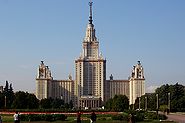
| |
| Established | 25 January 1755 |
|---|---|
| Location | Moscow, Russia |
| Website | http://www.msu.ru/en/ |
M.V. Lomonosov Moscow State University (Russian: Московский государственный университет имени М.В.Ломоносова, often abbreviated МГУ, MSU, MGU) is the largest university in Russia. Founded in 1755, it is also the oldest. As of 2004, the university has some 4,000 staff teaching 31,000 students and 7,000 postgraduates. Its current rector is Viktor Sadovnichiy.
Mission and Reputation
History
The university was established on the instigation of Ivan Shuvalov and Mikhail Lomonosov by a decree of Russian Empress Elizabeth dated January 25 (January 12 old style), 1755. First lessons were held on April 26. January 25 is still celebrated as Students' Day in Russia.
Originally located in the Principal Medicine Store on Red Square, the university was transferred by Catherine the Great to the present Neoclassical building on the other side of Mokhovaya Street. The main building was constructed between 1782 and 1793 to a Neo-Palladian design by Matvei Kazakov and rebuilt after Fire of Moscow (1812) by Domenico Giliardi.
In the 18th century, the university had three faculties: philosophy, medicine, and law. A college for future students was affiliated with the university before being abolished in 1812. In 1779, Mikhail Kheraskov founded a boarding school for noblemen (Благородный пансион), which was transformed into a gymnasium for the Russian nobility in 1830. The university press, run by Nikolay Novikov in the 1780s, published the most popular newspaper in Imperial Russia—Moskovskie Vedomosti.
In 1804, medical education was split into Clinical (therapy), Surgical, and Obstetrics faculties. In 1884-1897, the Department of Medicine, supported by private donations, City Hall, and the national government, built an extensive, 1.6 kilometer long, state-of-the-art medical campus in Devichye Pole, between the Garden Ring and Novodevichy Convent. It was designed by Konstantin Bykovsky, with University doctors like Nikolay Sklifosovskiy and Fyodor Erismann acting as consultants. The campus, and medical education in general, were separated from the University in 1918. Devichye Pole is now operated by the independent Moscow Medical Academy and various other state and private institutions.
In 1905, a social-democratic organization was created at the university calling for the tsar to be overthrown and for Russia to be turned into a republic. The Tsarist government repeatedly began closing the university. In 1911, in a protest over the introduction of troops onto the campus and mistreatment of certain professors, 130 scientists and professors resigned en masse, including prominent ones such as Nikolay Dimitrievich Zelinskiy, Pyotr Nikolaevich Lebedev, and Sergei Alekseevich Chaplygin. Thousands of students were also expelled.
After the October Revolution in 1917, the school began allowing the admission of children of the proletariat and peasants, not just those of the more well-to-do petits bourgeois. In 1919, tuition fees were done away with, and a preparatory facility was created for children of the working class so that they would be able to pass the admission examinations. The political repressions of the 1930s and 1950s negatively affected the development of scientific ideas, as Soviet scientists had virtually no contacts with their colleagues abroad, while certain branches of science were condemned as based on the ideology alien to Communist ideas, and a number of scientists and scholars were sentenced for life imprisonment.
The university was renamed in 1940 in honor of its founder Mikhail Lomonosov.
The Great Patriotic War against Fascism was one of the most difficult periods in the history of Russia. The first group of University students and staff joined the army on the third day of fighting. One of the divisions formed out of University volunteers fought heroically defending Moscow.
Moscow University professors, students and staff were evacuated during the war first to Ashkhabad, Turkmenia, then to Sverdlovsk, returning to Moscow in 1943, after the German troops were defeated near the capital. During the war over 3000 specialists were trained at the University; the University scientists continued their research; their contributions to applied science allowed improvements in aircraft development, in the accuracy of artillery fire etc. New explosives were invented, a study of uranium was carried out, a preparation causing blood coagulation was introduced into practice; University geologists discovered a tungsten deposit in Central Asia and new oil wells, University geographers supplied the Red Army with maps and charts. University scholars popularized the ideas patriotism, and University lawyers made their contribution during the Nuremberg and Tokyo trials.
During the post-war period the leading role of Moscow University in the restoration and further development of the country was fully recognized. There was a fivefold increase in the state funding, the new University campus was built on Vorobievy Gory (Sparrow Hills), where all the lecture halls and laboratories had the latest equipment available at the time.
After 1991, nine new faculties were established. In 1992, the university was granted a unique status: it is funded directly from the state budget (bypassing the ministry of education) which provides a significant level of independence.
Facilities
Since 1953, most of the faculties have been situated on Sparrow Hills, in the southwest of Moscow. The Main building was designed by architect Lev Vladimirovich Rudnev. In the post-war era, Stalin ordered seven huge tiered neoclassic towers built around the city. The MSU Main building is by far the largest of these. It was also the tallest building in the world outside of New York City at the time of its construction, and it remained the tallest building in Europe until 1988. The central tower is 240m tall, 36-stories high, and flanked by four huge wings of student and faculty accommodations. It is said to contain a total of 33 kilometers of corridors and 5,000 rooms. Facilities available inside the building include a concert hall, a theatre, a museum, various administration services, a library, a swimming pool, a police station, a post office, a laundry, a hairdresser's salon, a canteen, bank offices, shops, cafeterias, a bomb shelter, etc. Along with the university administration, four of the main faculties - Faculty of Mechanics and Mathematics, the Faculty of Geology, the Faculty of Geography, and the Faculty of Fine and Performing Arts - now remain in the Main buiding. The star on the top of the tower is large enough to include a small room and a viewing platform; it weighs 12 tons. The building's facades are ornamented with giant clocks, barometers, and thermometers, statues, carved wheat sheaves, and Soviet crests (recently renovated). It stands before a terrace featuring statues of male and female students gazing optimistically and confidently into the future.
While the Sparrow Hills were on the outskirts of the city at the time of the construction of the Main building, they are now about halfway from the Kremlin to the city limits. Several other buildings and sports facilities were later added to the city campus, including the only baseball stadium in Russia. Currently, a new building is under construction for the social sciences faculties, and a vast new facility has just been built for the library, which is the second largest in Russia by volume (number of books). The university also has several dormitory buildings in the southwest of Moscow outside the campus.
The historical buiding on Mokhovaya Street now houses mainly the Faculty of Journalism, the Faculty of Psychology, and the The Institute of Asian and African Studies.
Programs
Colleges
As of 2005, the university has 29 faculties and 15 research centers:
- Faculty of Mechanics and Mathematics
- Faculty of Computational Mathematics and Cybernetics
- Faculty of Physics
- Faculty of Chemistry
- Faculty of Biology
- Faculty of Bioengineering and Bioinformatics
- Faculty of Soil Science
- Faculty of Geology
- Faculty of Geography
- Faculty of Materials Science
- Faculty of Fundamental Medicine
- Faculty of History
- Faculty of Philology
- Faculty of Philosophy
- Faculty of Economics
- Higher School of Business Administration
- Faculty of Law
- Faculty of Journalism
- Faculty of Psychology
- The Institute of Asian and African Studies
- Faculty of Sociology
- Faculty of Foreign Languages and Area Studies
- Faculty of Public Administration
- Faculty of Fine and Performing Arts
- Faculty of World Politics
- Faculty of Education
- Faculty of Further Education
- Moscow School of Economics
- Faculty of Military Training
- Skobeltsyn Institute of Nuclear Physics
- Institute of Mechanics
- Sternberg Astronomical Institute
- A.N. Belozersky Institute of Physico-Chemical Biology
- Research Computing Center
- N.N.Bogoliubov Institute for Theoretical Problems of Microphysics
- White Sea Biological Station
- and several others
Student Life
Traditions
Famous alumni and faculty
Alexey Abrikosov · Pavel Alexandrov · Vladimir Arnold · Zalpa Bersanova · Pafnuty Chebyshev · Anton Chekhov · Boris Chicherin · Ekaterina Dashkova · Semyon Desnitsky · Vladimir Drinfel'd · Grigori Gamburtsev · Israel Gelfand · Vitaly Ginzburg · Mikhail Gorbachev · Alexander Herzen · C. A. R. Hoare · Ion Iliescu · Vyacheslav Ivanov · Wassily Kandinsky · Pyotr Kapitsa · Yuri Knorosov · Andrey Kolmogorov · Maxim Kontsevich · Igor Kurchatov · Lev Landau · Grigory Landsberg · Nikolai Luzin · Grigory Margulis · Nitiphoom Naowarat · Sergei Novikov · Andrei Okounkov · Olga Oleinik · Aleksandr Oparin · Ivan Petrovsky · Andrei Sakharov · Yakov Sinai · Sergey Stanishev · Igor Tamm · Vladimir Toporov · Nikolai Trubetzkoy
ReferencesISBN links support NWE through referral fees
- History of Moscow University – from the official website of MSU.
External links
- Moscow State University
- Moscow State University campus on Google Maps
- (Russian) MechMath faculty - Unofficial website
- (Russian) CMC faculty - Unofficial website
- (Russian) Journalism faculty - Unofficial website
Credits
New World Encyclopedia writers and editors rewrote and completed the Wikipedia article in accordance with New World Encyclopedia standards. This article abides by terms of the Creative Commons CC-by-sa 3.0 License (CC-by-sa), which may be used and disseminated with proper attribution. Credit is due under the terms of this license that can reference both the New World Encyclopedia contributors and the selfless volunteer contributors of the Wikimedia Foundation. To cite this article click here for a list of acceptable citing formats.The history of earlier contributions by wikipedians is accessible to researchers here:
The history of this article since it was imported to New World Encyclopedia:
Note: Some restrictions may apply to use of individual images which are separately licensed.
